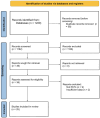High-Intensity Exercise Training Impact on Cardiorespiratory Fitness, Gait Ability, and Balance in Stroke Survivors: A Systematic Review and Meta-Analysis
- PMID: 39336984
- PMCID: PMC11432212
- DOI: 10.3390/jcm13185498
High-Intensity Exercise Training Impact on Cardiorespiratory Fitness, Gait Ability, and Balance in Stroke Survivors: A Systematic Review and Meta-Analysis
Abstract
Stroke survivors commonly face challenges such as reduced physical activity and cardiorespiratory fitness (CRF) as well as balance and gait impairments, exacerbating their disability. While high-intensity exercise interventions have demonstrated some potential, their effects on these items remain uncertain. Therefore, our study aimed to investigate the impact of high-intensity training protocols on CRF, gait ability, and balance in stroke survivor populations. Two independent investigators systematically searched five databases for relevant RCTs following the PICO model. Through a systematic review of 25 RCTs published up to 31 May 2023, including adult first-stroke survivors, comparing high-intensity exercise training versus low-to-mild or no exercises, we evaluated outcomes such as the Six-Minute Walking Test (6 MWT), peak oxygen uptake (VO2peak), Ten-Meter Walk Test (10 MWT), Berg Balance Scale (BBS), and Timed Up and Go test (TUG). The protocol was registered in PROSPERO (registration number CRD42023456773). Meta-analyses indicated significant enhancements in CRF, as measured by 6 MWT and VO2peak, following high-intensity exercise interventions. However, no significant differences were observed in BBS, 10 MWT, and TUG. Our findings underscore the potential of high-intensity exercise interventions in ameliorating CRF among stroke survivors, although further research involving standardized protocols and long-term follow-ups is imperative to optimize rehabilitation outcomes.
Keywords: cardio-respiratory fitness; high-intensity exercise; high-intensity training; meta-analysis; rehabilitation; stroke.
Conflict of interest statement
The authors declare no conflicts of interest.
Figures











References
-
- Benjamin E.J., Muntner P., Alonso A., Bittencourt M.S., Callaway C.W., Carson A.P., Chamberlain A.M., Chang A.R., Cheng S., Das S.R., et al. Heart Disease and Stroke Statistics—2019 Update: A Report from the American Heart Association. Circulation. 2019;139:e56–e528. doi: 10.1161/CIR.0000000000000659. - DOI - PubMed
-
- Martin S.S., Aday A.W., Almarzooq Z.I., Anderson C.A., Arora P., Avery C.L., Baker-Smith C.M., Gibbs B.B., Beaton A.Z., Boehme A.K., et al. 2024 Heart Disease and Stroke Statistics: A Report of US and Global Data From the American Heart Association. Circulation. 2024;149:e347–e913. doi: 10.1161/CIR.0000000000001209. - DOI - PubMed
-
- Billinger S.A., Arena R., Bernhardt J., Eng J.J., Franklin B.A., Johnson C.M., MacKay-Lyons M., Macko R.F., Mead G.E., Roth E.J., et al. Physical activity and exercise recommendations for stroke survivors: A statement for healthcare professionals from the American Heart Association/American Stroke Association. Stroke. 2014;45:2532–2553. doi: 10.1161/STR.0000000000000022. - DOI - PubMed
Publication types
LinkOut - more resources
Full Text Sources

